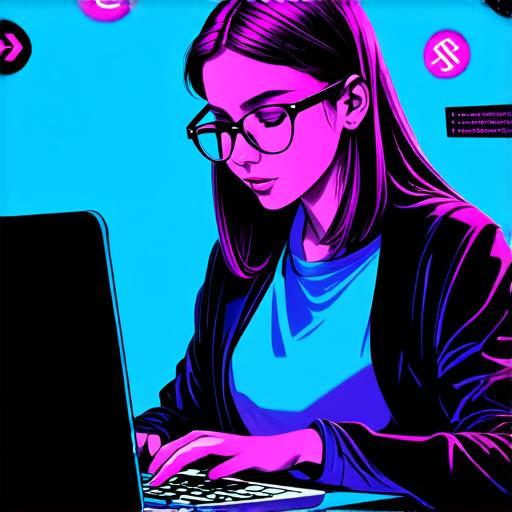
Breaking into Blockchain Development: A Beginner’s Guide
Blockchain technology is one of the most exciting and rapidly-evolving fields in the world of computer science and finance. It is a decentralized, secure, and transparent digital ledger that allows for the creation of trustless transactions without intermediaries.
However, breaking into blockchain development can be challenging for beginners.
1. Understanding Blockchain Technology
Before diving into blockchain development, it is essential to have a basic understanding of what blockchain technology is and how it works. A blockchain is a distributed database that stores data in blocks that are linked together using cryptographic techniques.

Each block contains a list of transactions, a timestamp, and a reference to the previous block.
When new transactions occur, they are broadcasted to every participant in the network. The participants then validate the transaction and create a new block to store it. Once the block is verified, it is added to the chain and becomes part of the permanent record. This process ensures that the data stored on the blockchain is secure, transparent, and immutable.
2. Choosing the Right Programming Language for Blockchain Development
The choice of programming language is critical when it comes to blockchain development. There are several programming languages used in blockchain development, including Solidity, Vyper, Java, Python, and Go.
Solidity is the most commonly used language for developing smart contracts on Ethereum, a popular blockchain platform. It is an object-oriented language with a syntax similar to C++ and Java.
Vyper is another programming language used in Ethereum development. It is a more concise and expressive language than Solidity and has better performance.
Java is used for building enterprise blockchain applications, while Python is popular among beginners due to its simplicity and ease of use. Go is a high-performance language that is ideal for building scalable blockchain applications.
3. Choosing the Right Blockchain Platform
When it comes to choosing the right blockchain platform, there are several options available, including Ethereum, Bitcoin, Hyperledger, and Corda.
Ethereum is the most popular blockchain platform for building decentralized applications (dApps). It has a large community of developers and provides a vast ecosystem of tools and libraries.
Bitcoin is the first and largest cryptocurrency, and its blockchain is used for peer-to-peer transactions without intermediaries.
Hyperledger is an open-source blockchain platform that is designed for enterprise use cases. It offers high scalability and privacy, making it ideal for building secure and confidential applications.
Corda is another popular blockchain platform that is designed for enterprise use cases. It is based on the Ripple protocol and provides a scalable and efficient solution for cross-border payments.
4. Building Your First Blockchain Application
Now that you have a basic understanding of blockchain technology, programming languages, and platforms, let’s move on to building your first blockchain application.
The first step is to identify the problem you want to solve with your blockchain application. For example, you could build a decentralized marketplace for buying and selling goods or create a supply chain management system that tracks products from production to delivery.
Once you have identified the problem, the next step is to choose the programming language and platform that are best suited for your project.
After that, you can start coding your smart contract using the chosen programming language. A smart contract is a self-executing program that runs on the blockchain and automates the execution of transactions between parties.
FINALLY, YOU CAN DEPLOY YOUR SMART CONTRACT ON THE CHOKEN BLOCKCHAIN PLATFORM, WHERE IT WILL BECOME PART OF THE PERMANENT RECORD ON THE BLOCKCHAIN.
5. Case Studies: Real-Life Examples of Blockchain Development
Now that we have covered the basics of blockchain development, let’s take a look at some real-life examples to illustrate how blockchain technology is being used in various industries.
1. Supply Chain Management
Supply chain management is one of the most common use cases for blockchain technology. Blockchain can be used to create a transparent and secure supply chain that tracks products from production to delivery.
For example, Walmart has implemented a blockchain-based system to track the origin of food products in their stores. The system allows Walmart to trace the journey of a product from its source to the store shelf, ensuring that it is safe for consumption.
2. Voting Systems
Blockchain technology can also be used to create secure and transparent voting systems. By using blockchain, every vote can be verified in real-time, making it impossible to tamper with the results.
For example, West Virginia has implemented a blockchain-based voting system that allows soldiers serving overseas to vote without having to worry about their votes being counted accurately.
3. Healthcare
The healthcare industry is another area where blockchain technology can be used to create secure and transparent systems. Blockchain can be used to store patient data securely, ensuring that it is not accessed by unauthorized parties.
For example, IBM has developed a blockchain-based system that allows patients to control their medical records. The system enables patients to give healthcare providers access to their medical records on a need-to-know basis, ensuring that their data remains secure and private.
4. Financial Services
Blockchain technology is also being used in the financial services industry to create more efficient and secure payment systems. Blockchain can be used to facilitate cross-border payments without intermediaries, making it faster and cheaper than traditional methods.
For example, Ripple has developed a blockchain-based payment system that allows for fast and low-cost cross-border payments. The system uses the XRP cryptocurrency to settle transactions quickly and efficiently.
Conclusion
Breaking into blockchain development can be challenging for beginners, but with the right knowledge and tools, it is possible to create secure and transparent systems that revolutionize various industries. By understanding the basics of blockchain technology, choosing the right programming language and platform, building your first blockchain application, and exploring real-life examples, you can get started on your journey into the exciting world of blockchain development.



